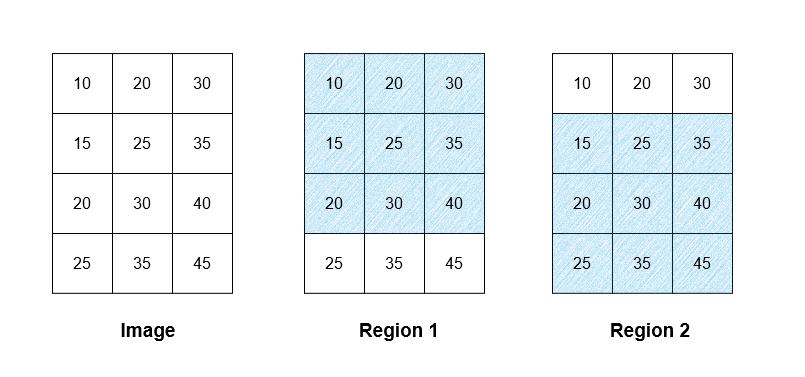class Solution {
public:
vector<vector<int>> resultGrid(vector<vector<int>>& image, int threshold) {
}
};
3030. 找出网格的区域平均强度
给你一个下标从 0 开始、大小为 m x n 的网格 image ,表示一个灰度图像,其中 image[i][j] 表示在范围 [0..255] 内的某个像素强度。另给你一个 非负 整数 threshold 。
如果 image[a][b] 和 image[c][d] 满足 |a - c| + |b - d| == 1 ,则称这两个像素是 相邻像素 。
区域 是一个 3 x 3 的子网格,且满足区域中任意两个 相邻 像素之间,像素强度的 绝对差 小于或等于 threshold 。
区域 内的所有像素都认为属于该区域,而一个像素 可以 属于 多个 区域。
你需要计算一个下标从 0 开始、大小为 m x n 的网格 result ,其中 result[i][j] 是 image[i][j] 所属区域的 平均 强度,向下取整 到最接近的整数。如果 image[i][j] 属于多个区域,result[i][j] 是这些区域的 “取整后的平均强度” 的 平均值,也 向下取整 到最接近的整数。如果 image[i][j] 不属于任何区域,则 result[i][j] 等于 image[i][j] 。
返回网格 result 。
示例 1:

输入:image = [[5,6,7,10],[8,9,10,10],[11,12,13,10]], threshold = 3 输出:[[9,9,9,9],[9,9,9,9],[9,9,9,9]] 解释:图像中存在两个区域,如图片中的阴影区域所示。第一个区域的平均强度为 9 ,而第二个区域的平均强度为 9.67 ,向下取整为 9 。两个区域的平均强度为 (9 + 9) / 2 = 9 。由于所有像素都属于区域 1 、区域 2 或两者,因此 result 中每个像素的强度都为 9 。 注意,在计算多个区域的平均值时使用了向下取整的值,因此使用区域 2 的平均强度 9 来进行计算,而不是 9.67 。
示例 2:

输入:image = [[10,20,30],[15,25,35],[20,30,40],[25,35,45]], threshold = 12 输出:[[25,25,25],[27,27,27],[27,27,27],[30,30,30]] 解释:图像中存在两个区域,如图片中的阴影区域所示。第一个区域的平均强度为 25 ,而第二个区域的平均强度为 30 。两个区域的平均强度为 (25 + 30) / 2 = 27.5 ,向下取整为 27 。图像中第 0 行的所有像素属于区域 1 ,因此 result 中第 0 行的所有像素为 25 。同理,result 中第 3 行的所有像素为 30 。图像中第 1 行和第 2 行的像素属于区域 1 和区域 2 ,因此它们在 result 中的值为 27 。
示例 3:
输入:image = [[5,6,7],[8,9,10],[11,12,13]], threshold = 1 输出:[[5,6,7],[8,9,10],[11,12,13]] 解释:图像中不存在任何区域,因此对于所有像素,result[i][j] == image[i][j] 。
提示:
3 <= n, m <= 5000 <= image[i][j] <= 2550 <= threshold <= 255
原站题解